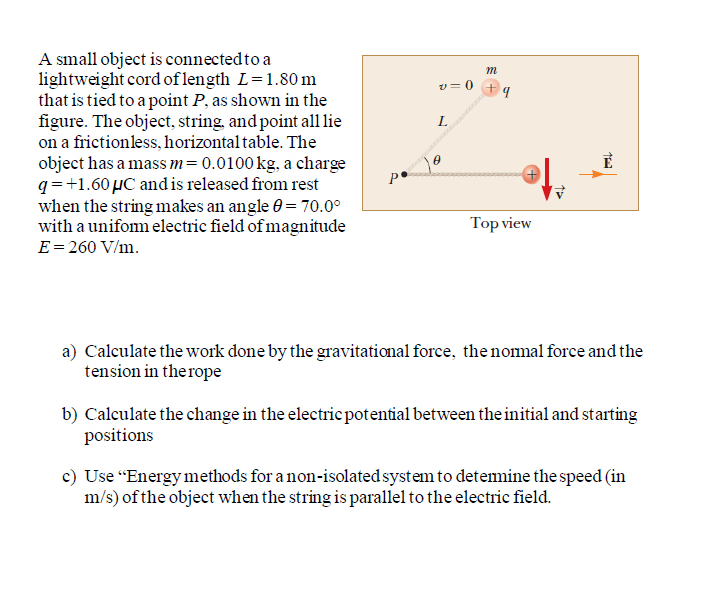A small object is connected to a lightweight cord of length L=1.80 m that is tied to a point P, as shown in the figure. The object, string, and point all lie on a frictionless, horizontal table. The object has a mass m=0.0100 kg, a charge q=+1.60 µC and is released from rest when the string makes an angle 0 = 70.0° with a unifomm electric field of magnitude E= 260 V/m.
A small object is connected to a lightweight cord of length L=1.80 m that is tied to a point P, as shown in the figure. The object, string, and point all lie on a frictionless, horizontal table. The object has a mass m=0.0100 kg, a charge q=+1.60 µC and is released from rest when the string makes an angle 0 = 70.0° with a unifomm electric field of magnitude E= 260 V/m.
Chapter5: Electric Charges And Fields
Section: Chapter Questions
Problem 66P: On a typical clear day, the atmospheric electric field points downward and has a magnitude of...
Related questions
Question

Transcribed Image Text:A small object is connectedto a
lightweight cord oflength L=1.80 m
that is tied to a point P, as shown in the
figure. The object, string, and point all lie
on a frictionless, horizontaltable. The
v = 0
L
object has a mass m=0.0100 kg, a charge
q=+1.60 µC and is released from rest
when the string makes an angle 0 = 70.0°
with a unifom electric field of magnitude
Тоp view
E= 260 V/m.
a) Calculate the work done by the gravitational force, the nomal force and the
tension in therope
b) Calculate the change in the electric potential between the initial and starting
positions
c) Use “Energy methods for a non-isolated system to detemine the speed (in
m/s) of the object when the string is parallel to the electric field.
Expert Solution
This question has been solved!
Explore an expertly crafted, step-by-step solution for a thorough understanding of key concepts.
Step by step
Solved in 4 steps with 2 images

Knowledge Booster
Learn more about
Need a deep-dive on the concept behind this application? Look no further. Learn more about this topic, physics and related others by exploring similar questions and additional content below.Recommended textbooks for you



Physics for Scientists and Engineers, Technology …
Physics
ISBN:
9781305116399
Author:
Raymond A. Serway, John W. Jewett
Publisher:
Cengage Learning



Physics for Scientists and Engineers, Technology …
Physics
ISBN:
9781305116399
Author:
Raymond A. Serway, John W. Jewett
Publisher:
Cengage Learning

Classical Dynamics of Particles and Systems
Physics
ISBN:
9780534408961
Author:
Stephen T. Thornton, Jerry B. Marion
Publisher:
Cengage Learning

Physics for Scientists and Engineers: Foundations…
Physics
ISBN:
9781133939146
Author:
Katz, Debora M.
Publisher:
Cengage Learning

Glencoe Physics: Principles and Problems, Student…
Physics
ISBN:
9780078807213
Author:
Paul W. Zitzewitz
Publisher:
Glencoe/McGraw-Hill